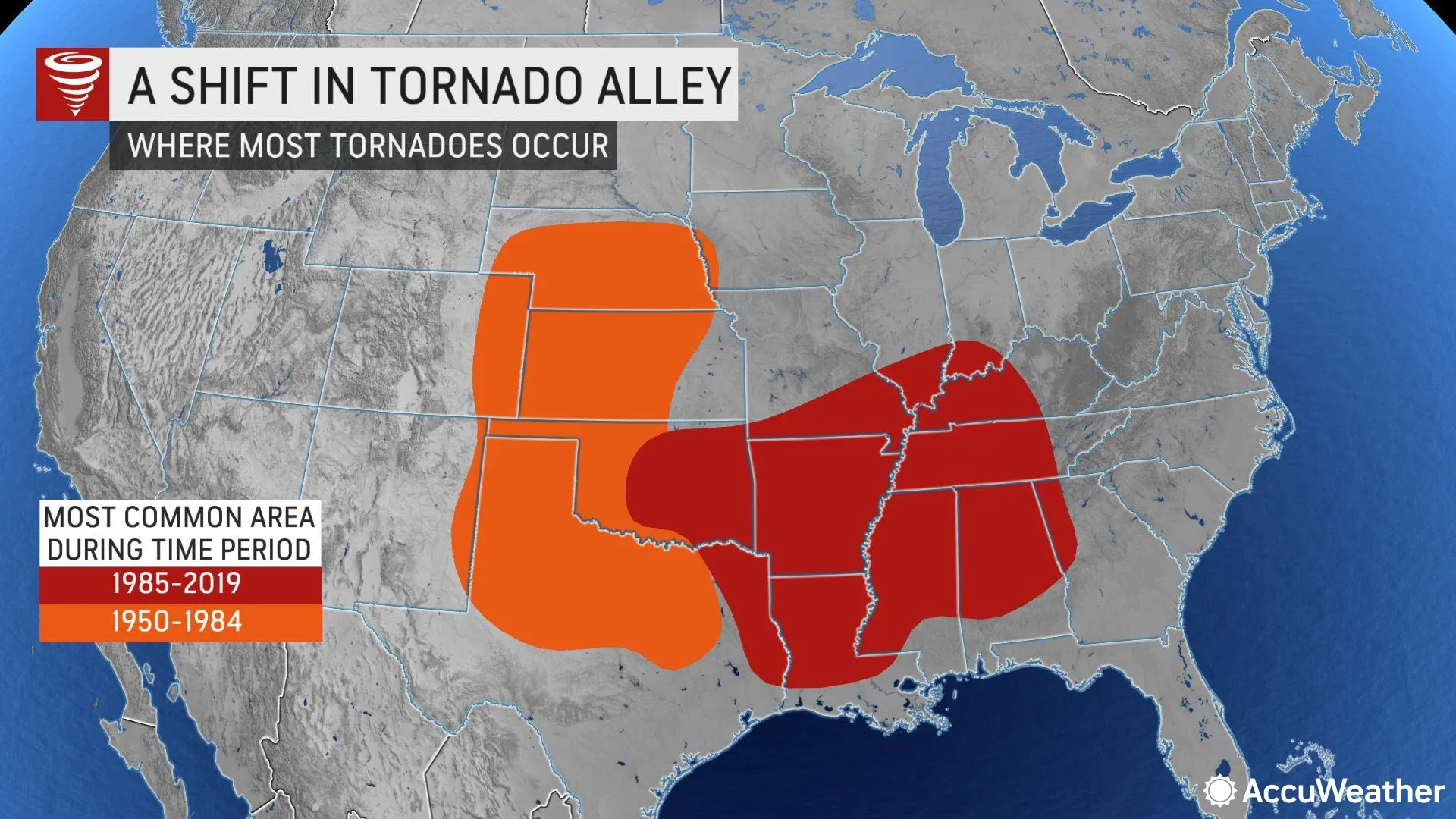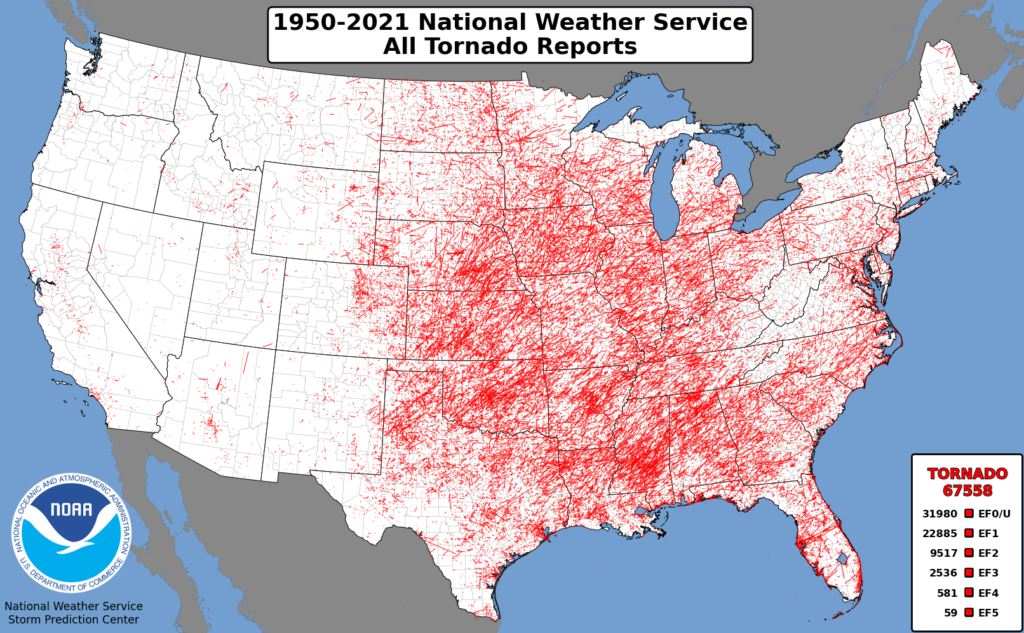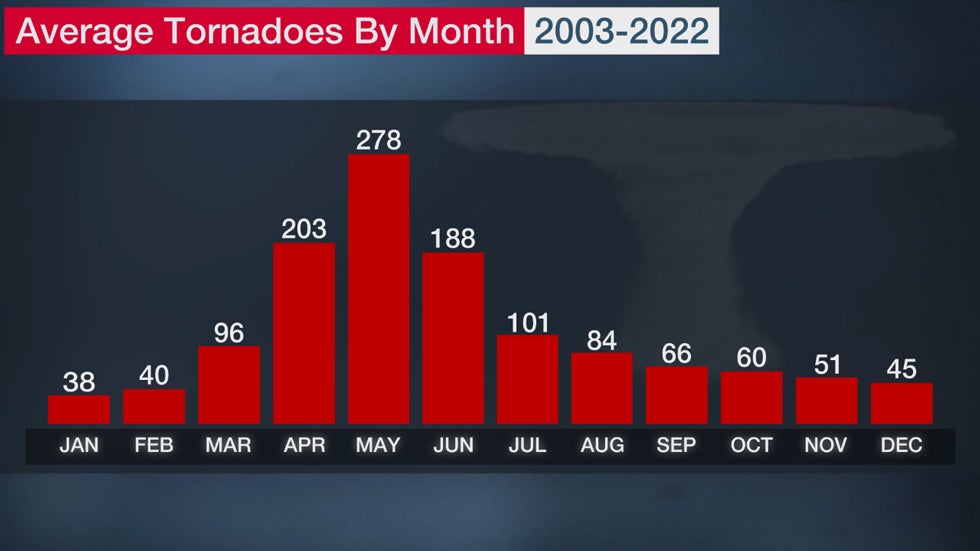Hello everyone! Thank you for taking the time to read my second summer project. Instead of looking at a particular storm or event, I wanted to change things slightly. For my topic today, I wanted to discuss the significant and enlightening “shift of Tornado Alley. For most of this post, I will discuss a recent study titled “A Comprehensive Analysis of the Spatial and Seasonal Shifts in Tornado Activity in the United States” by Timothy Coleman, Richard Thompson, and Gregory Forbes. This study focuses on the geographic and seasonal shift of tornados in the United States over the past several decades. I will also be pulling bits and pieces from other articles, and all sources will be made available at the end of the post. Let’s get into it!
Everyone in the US has most likely heard the phrase “Tornado Alley” at least once in their life. This region, located in the central Great Plains, stretches from Texas to the Dakotas. The term “Tornado Alley” was coined in 1952 after meteorologists Robert Miller and Ernest Fawbush researched severe weather in Oklahoma and Texas, noticing a high frequency of tornadoes in the region. These two experts were also responsible for the first-ever tornado forecast in 1948. It is also widely known that “tornado season” occurs during the warm months (March-August), peaking around April and May. However, recent studies show an increase in tornadoes during the cold season (September-February), posing a more significant risk as people are less accustomed to tornadoes during colder months and thus less aware. However, there seem to be some changes in recent years.


The Tornado Alley region has been defined this way for over 50 years, leading to the misconception that tornadoes are more common here than elsewhere in the US. While this region still reports many tornadoes each year, research indicates a shift in higher tornado frequencies to the east, particularly in the lower Mississippi River Valley and surrounding areas in the Southeast. Researchers believe the conditions for these dangerous storms—warm temperatures, wind shear, and abundant moisture—are becoming more prevalent in this area. This increase in factors necessary for tornadic activity has made this area a popular hotspot for tornados, ranging from all strengths and large tornado outbreaks.
This region has come to be known as “Dixie Alley,” an extension of Tornado Alley in the Southeast. The term “Dixie Alley” was coined by Alan Pearson after the 1971 tornado outbreak in the Delta region (Arkansas/Mississippi). This “Dixie Alley” is separated from the original Tornado Alley by the Ozark Mountains, an area with little to no tornadic activity. If not for this barrier, “Dixie Alley” and Tornado Alley might be a continuous region of increased tornado occurrences.
The first idea this study focuses on is the geographical shift of tornado activity. Three experimental factors—the annual number of tornados, the yearly number of days with a tornado, and the annual tornado path length—were used to provide more insight into why this shift is occurring.
Firstly, the number of tornadoes in the western US has decreased by 34%, while the eastern US has seen a 60% increase. Secondly, although tornado days have decreased in both regions over the years, the west has reduced more than the east. Lastly, tornado path lengths in the west have declined by 35% while increasing by 46% in the east. These results indicate that the increase in tornado activity in the eastern US nearly matches the decrease in the western US. While tornado touchdowns have decreased in the Great Plains in recent years, it remains a very active and dangerous area.
An important note for these results is that EF0-ranked tornado reports were excluded to ensure stability. Newer data and technology have also allowed for better reporting strategies to develop, which would result in more tornados in the recent decades compared to further back in time.


Another area of interest in this study is that more tornados occur in the colder months. Cold-season tornadoes are also becoming more common, primarily in the Southeast, and challenge the idea of a set “tornado season” since, with the right conditions, tornadoes can occur at any time of the year.
Some experts believe this is due to the increase in eastern US tornados. Looking at some percentages, comparing the two separate time frames (1951-1985 and 1986-2020) and the nationally recorded tornados reveals a 25% increase in the spring, a 37% decrease in the summer, an 80% increase in the fall, and a 102% increase in the winter. Summer saw the slightest change, while fall and winter showed drastic increases. These percentages may be misleading since the overall number of fall/winter tornados is still much lower than spring numbers. However, it still indicates that more tornados occur in the colder months.
To find these results, experts took the tornado reports from the past several decades and viewed trends for each of the four seasons. The most significant number of tornados occurred in the spring, while the least happened in the fall. While the least amount occurred in the fall, there are still more occurrences than in recent decades. Nearly all of the reported winter tornados were located in the Southeast, and there has also been an increase with time. Overall, while the numbers are still not as high as spring tornados, numbers are increasing for the colder months
FINAL THOUGHTS
The increasing occurrence of tornados outside of Tornado Alley and the traditional tornado season is a clear indication that we can no longer rely on past assumptions. It’s crucial to be prepared year-round for these storms and always have a way to access weather alerts for tornado updates. This is especially important from the Great Plains to the East Coast and all areas in between. By staying vigilant, we can take responsibility for our safety in the face of these changing tornado patterns.
This study was impactful and provided plenty of valid reasoning for bringing attention to this topic. As someone from the Southeast who has grown up seeing the increase in tornadic activity, I enjoyed learning more about this topic since it will ultimately impact my family and others I know and love. The potential impact of this study’s findings on our daily lives is significant, making it a topic of great interest and relevance.
For further research, I would love to see more concrete information on the causes of this geographical and seasonal shifts. This study focused more on reports and data from previous decades, so having some causes to watch out for would be amazing.
SOURCES:
Gensini, V. A., & Brooks, H. E. (2018). Spatial Trends in United States Tornado Frequency. NPJ Climate and Atmospheric Science, 1, 38. https://doi.org/10.1038/s41612-018-0048-2
Coleman, T. A., Thompson, R. L., & Forbes, G. S. (2024). A Comprehensive Analysis of the Spatial and Seasonal Shifts in Tornado Activity in the United States. Journal of Applied Meteorology and Climatology, 63(6), 717-730. https://doi.org/10.1175/JAMC-D-23-0143.1
Dixon, P. G., Mercer, A. E., Choi, J., & Allen, J. S. (2010). Tornado risk analysis: Is Dixie Alley an extension of Tornado Alley? Bulletin of the American Meteorological Society, 91(9), 1023-1034. https://doi.org/10.1175/2010BAMS3102.1

